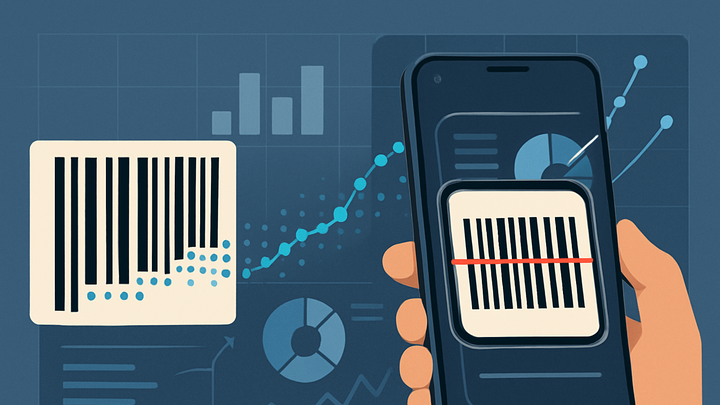Published on 2025-06-27T20:55:42Z
What is a Barcode? Examples for Barcode Tracking in Analytics
Barcode is a machine-readable code in the form of parallel lines representing data. In analytics, barcodes serve as unique identifiers for physical items, enabling automated data capture when the code is scanned. This process links a real-world object to digital records, allowing businesses to track inventory movements, sales transactions, and custom events. By integrating barcode scan data into analytics platforms, organizations can achieve greater operational efficiency, reduce manual errors, and gain insights into product performance and customer behavior. Whether used in retail, logistics, or manufacturing, barcodes bridge the physical and digital realms, enhancing data-driven decision-making.
Barcode
Barcodes encode data in visual patterns for quick scanning and support analytics-driven tracking of inventory, sales, and custom events.
What is a Barcode?
A barcode is a method of representing data in a visual, machine-readable form. It consists of parallel lines (or patterns) of varying widths and spacing that encode information, typically numeric or alphanumeric. In analytics, barcodes serve as unique identifiers for products, shipments, or items, enabling automated data capture during scan events. By scanning a barcode, systems can instantly fetch or log associated data, enhancing accuracy and efficiency. Barcodes underpin many analytics processes by linking physical items to digital records.
-
Visual encoding
Barcodes use a series of parallel lines or patterns, with varying widths and spaces representing different data values. Each pattern corresponds to a specific value, which can be decoded by scanners or cameras.
-
Types of barcodes
Common barcode formats include UPC, EAN, Code 128, and GS1 DataBar, each suited for different use cases and data capacities.
-
Integration with analytics
When a barcode is scanned, the scan event can be captured as part of analytics data. This allows businesses to track inventory movements, sales transactions, and other metrics associated with the scanned item.
Why Barcodes Matter in Analytics
Barcodes drive operational efficiency and data accuracy by automating the capture of key business events. They reduce manual entry errors, accelerate checkout processes, and provide granular insights into product movement. Analytics powered by barcode data helps businesses optimize inventory levels, forecast demand, and understand customer purchase patterns. Real-time scanning data can feed dashboards and trigger alerts, enabling swift decision-making. Ultimately, barcodes serve as a critical link between the physical and digital realms in retail, logistics, and manufacturing analytics.
-
Inventory management
Barcode scans provide real-time inventory updates, reducing stockouts and overstock scenarios.
-
Sales tracking
At point of sale, barcodes automatically log product sales, feeding revenue and product performance reports.
-
Customer behavior insights
Scanned barcodes can be tied to customer profiles or loyalty programs to analyze purchase trends and preferences.
Implementing Barcode Tracking with PlainSignal and GA4
This section provides practical examples for adding barcode scan analytics to your website or application using PlainSignal (cookie-free analytics) and Google Analytics 4. You’ll learn how to insert tracking scripts and send custom events when a barcode is scanned. These examples assume you have basic access to your site’s HTML and JavaScript. Customize the code with your own IDs and event parameters to fit your tracking needs. Use these snippets as a starting point to integrate barcode event data into your analytics dashboards.
-
PlainSignal setup
Add the PlainSignal script to your HTML’s
<head>section to enable cookie-free analytics collection.-
Tracking script
<link rel="preconnect" href="//eu.plainsignal.com/" crossorigin /> <script defer data-do="yourwebsitedomain.com" data-id="0GQV1xmtzQQ" data-api="//eu.plainsignal.com" src="//cdn.plainsignal.com/plainsignal-min.js"></script>
-
-
GA4 setup
Insert the GA4 gtag.js snippet into your HTML to begin collecting data.
-
GA4 script
<script async src="https://www.googletagmanager.com/gtag/js?id=G-XXXXXXXXXX"></script> <script> window.dataLayer = window.dataLayer || []; function gtag(){dataLayer.push(arguments);} gtag('js', new Date()); gtag('config', 'G-XXXXXXXXXX'); </script>
-
-
Tracking a barcode scan event
Use JavaScript to detect barcode scans (e.g., via a scanner input or camera library) and send custom events to both platforms.
-
PlainSignal event tracking
// Example: track a barcode scan const scannedCode = '123456789012'; window.PlainSignal.track('barcode_scan', { code: scannedCode }); -
GA4 event tracking
// Example: track a barcode scan gtag('event', 'barcode_scan', { 'barcode_value': '123456789012' });
-
